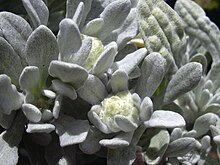Gnaphalium
| cudweeds | |
|---|---|

| |
| Gnaphalium sandwicensium from Hawai'i | |
| Scientific classification | |
| Kingdom: | Plantae |
| Clade: | Tracheophytes |
| Clade: | Angiosperms |
| Clade: | Eudicots |
| Clade: | Asterids |
| Order: | Asterales |
| Family: | Asteraceae |
| Tribe: | Gnaphalieae |
| Genus: | Gnaphalium L. 1753 not Adans. 1763 |
| Type species | |
| Gnaphalium luteoalbum[1][2] | |
| Synonyms[3] | |
| |
Gnaphalium is a genus of flowering plants in the sunflower family,[2][4] commonly called cudweeds. They are widespread and common in temperate regions, although some are found on tropical mountains or in the subtropical regions of the world.
Cudweeds are important foodplants for American painted lady caterpillars.
Species
Species in this genus include:[3]
- Gnaphalium adnatum
- Gnaphalium albescens
- Gnaphalium aldunateoides
- Gnaphalium americanum
- Gnaphalium andicola
- Gnaphalium antennarioides
- Gnaphalium antillanum
- Gnaphalium austroafricanum
- Gnaphalium badium
- Gnaphalium baicalense
- Gnaphalium cabrerae
- Gnaphalium calviceps
- Gnaphalium capense
- Gnaphalium caucasicum
- Gnaphalium cheiranthifolium
- Gnaphalium chimborazense
- Gnaphalium chrysocephalum
- Gnaphalium clemensiae
- Gnaphalium coarctatum
- Gnaphalium confine
- Gnaphalium coquimbense
- Gnaphalium crispatulum
- Gnaphalium cymatoides
- Gnaphalium decipiens
- Gnaphalium declinatum
- Gnaphalium demidium
- Gnaphalium diamantinense
- Gnaphalium dysodes
- Gnaphalium diminutivum
- Gnaphalium diminutum
- Gnaphalium dombeyanum
- Gnaphalium ecuadorense
- Gnaphalium englerianum
- Gnaphalium exilifolium
- Gnaphalium filagineum
- Gnaphalium filagopsis
- Gnaphalium flaccidum
- Gnaphalium flavescens
- Gnaphalium flavocephalum
- Gnaphalium frigidum
- Gnaphalium gayanum
- Gnaphalium genevoisii
- Gnaphalium glanduliferum
- Gnaphalium glandulosum
- Gnaphalium gnaphalioides
- Gnaphalium gnaphalodes
- Gnaphalium graveolens
- Gnaphalium grayi
- Gnaphalium griquense
- Gnaphalium hawaiiense
- Gnaphalium heleios
- Gnaphalium heterotrichum
- Gnaphalium hintoniorum
- Gnaphalium hoppeanum
- Gnaphalium indutum
- Gnaphalium jamaicense
- Gnaphalium jelskii
- Gnaphalium jujuyense
- Gnaphalium kasachstanicum
- Gnaphalium lacteum
- Gnaphalium landbeckii
- Gnaphalium leontopodium
- Gnaphalium leucopeplum
- Gnaphalium leucopilinum
- Gnaphalium limicola
- Gnaphalium linearum
- Gnaphalium mandshuricum
- Gnaphalium melanosphaeroides
- Gnaphalium meridanum
- Gnaphalium moelleri
- Gnaphalium montevidense
- Gnaphalium nanchuanense
- Gnaphalium nelsonii
- Gnaphalium norvegicum
- Gnaphalium palustre
- Gnaphalium panniforme
- Gnaphalium paramorum
- Gnaphalium parviflorum
- Gnaphalium pauciflorum
- Gnaphalium pedunculatum
- Gnaphalium pensylvanicum
- Gnaphalium perpusillum
- Gnaphalium peruvianum
- Gnaphalium phaeolepis
- Gnaphalium pichleri
- Gnaphalium pilulare
- Gnaphalium polium
- Gnaphalium polycaulon
- Gnaphalium polycephalum
- Gnaphalium pratense
- Gnaphalium pseudohelichrysum
- Gnaphalium psilophyllum
- Gnaphalium puberulum
- Gnaphalium pulchrum
- Gnaphalium purpureum
- Gnaphalium remyanum
- Gnaphalium rhodarum
- Gnaphalium robustum
- Gnaphalium roeseri
- Gnaphalium rossicum
- Gnaphalium rosulatum
- Gnaphalium ruricola
- Gnaphalium sandwicensium
- Gnaphalium schlimii
- Gnaphalium selleanum
- Gnaphalium simii
- Gnaphalium stagnalis
- Gnaphalium stewartii
- Gnaphalium stolonatum
- Gnaphalium supinum
- Gnaphalium sylvaticum
- Gnaphalium tarapacanum
- Gnaphalium thomsonii
- Gnaphalium tranzschelii
- Gnaphalium uliginosum
- Gnaphalium unionis
- Gnaphalium ustulatum
- Gnaphalium versatile
- Gnaphalium vestitum
- Gnaphalium viravira
- Gnaphalium yalaense

Formerly included
Numerous species have at one time been included in Gnaphalium,[3] but are now considered to belong to other genera: Achyrocline, Aliella, Ammobium, Anaphalioides, Anaphalis, Anaxeton, Antennaria, Argyrotegium, Belloa, Berroa, Blumea, Castroviejoa, Chevreulia, Chionolaena, Chrysocephalum, Dolichothrix, Edmondia, Euchiton, Ewartia, Facelis, Filago, Galeomma, Gamochaeta, Gnomophalium, Helichrysum, Ifloga, Laphangium, Lasiopogon, Leontonyx, Leontopodium, Leucogenes, Logfia, Lucilia, Luciliocline, Metalasia, Micropsis, Neojeffreya, Novenia, Ozothamnus, Pentzia, Petalacte, Phagnalon, Pilosella, Plecostachys, Pseudognaphalium, Pterocaulon, Rhodanthe, Raoulia, Schizogyne, Staehelina, Stuckertiella, Syncarpha, Troglophyton, Vellereophyton, Xerochrysum
Secondary metabolites
Gnaphalium species are known to contain flavonoids and diterpenes. Recently, two unique caffeoyl-D-glucaric acid derivatives, leontopodic acid and leontopodic acid B formerly only known from Leontopodium alpinum (L.) Cass. were detected in various species of Gnaphalium together with similar formerly unknown compounds.[5]
References
- ^ lectotype designated by Britton & Brown, Illustrated Flora of North America 3: 453. 1913
- ^ a b Tropicos, Gnaphalium L.
- ^ a b c Flann, C (ed) 2009+ Global Compositae Checklist search for Gnaphalium
- ^ Linnaeus, Carl von. 1753. Species Plantarum 2: 850-857 in Latin
- ^ Cicek, S; Untersulzner, C; Schwaiger, S; Zidorn, C (July 2012). "Caffeoyl-D-glucaric acid derivatives in the genus Gnaphalium (Asteraceae: Gnaphalieae)" (Free full text). Records of Natural Products (Gebze-Kocaeli , Türkiye). 6 (3): 311–315. ISSN 1307-6167.
